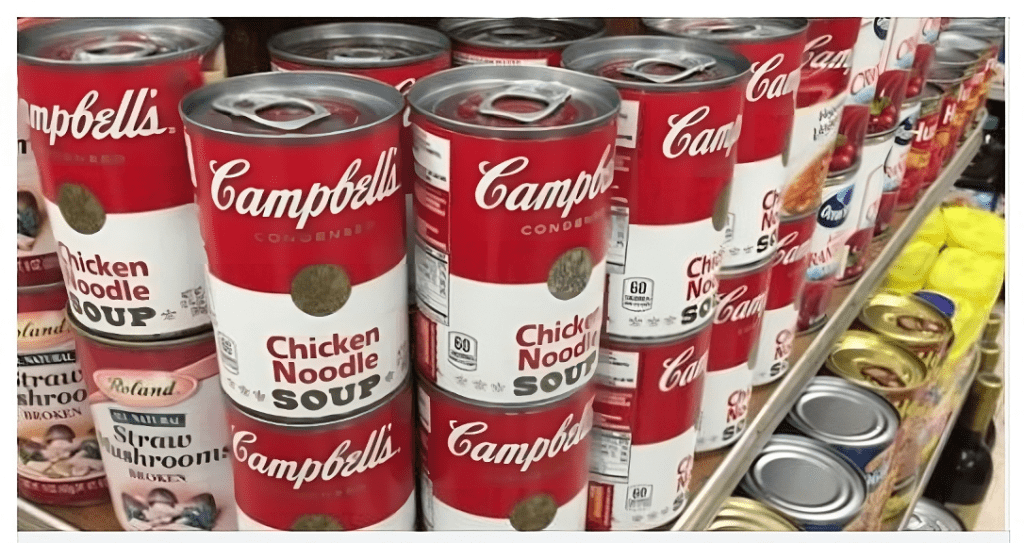For nearly two centuries, Campbell’s Soup has been a staple in American kitchens, with its iconic red and white cans symbolizing comfort and convenience. However, recent reports suggest that Campbell’s is facing one of the most significant crises in its long history. Internal conflicts and shifting consumer preferences are threatening the company’s future. Could this be the beginning of the end for Campbell’s, or will the brand find a way to adapt and survive?

Founded in 1869, Campbell’s Soup quickly became synonymous with affordable and easy-to-prepare meals. It wasn’t just a brand; it became a part of American culture. Classics like Chicken Noodle Soup and Tomato Soup paired with grilled cheese have become the ultimate comfort foods for generations. The brand grew on the promise of quality and convenience, earning its place in millions of homes.
One key to Campbell’s success has been its unmistakable branding. Introduced in 1898, the iconic red and white label is instantly recognizable. For decades, this simple yet powerful branding symbolized reliability and consistency, helping Campbell’s stand out on grocery store shelves. But as consumer preferences evolve, Campbell’s faces a challenge in maintaining its relevance while keeping its core image intact.
In recent years, there’s been a noticeable shift in how consumers approach food. Many Americans are moving away from processed and canned goods, opting instead for fresh, organic, and natural products. This change in consumer behavior is a significant challenge for Campbell’s, whose lineup relies heavily on shelf-stable, processed foods. As more people focus on health and wellness, Campbell’s must rethink its product offerings to meet these modern demands.
In response to the decline in traditional product sales, Campbell’s attempted to diversify its portfolio by acquiring other food companies. Unfortunately, these efforts have largely fallen flat, and the company now finds itself saddled with $9 billion in debt. Despite the acquisitions, Campbell’s struggles to compete in a market increasingly dominated by fresh and organic food options. The question now is whether Campbell’s can innovate fast enough to regain its footing.
At the heart of Campbell’s current crisis is an intense internal struggle between the Dorrance family, which owns 40% of the company’s shares, and Third Point, a hedge fund led by activist investor Daniel Loeb. While the Dorrance family prefers to stick with Campbell’s traditional business strategies, Third Point has been pushing for major changes, including recipe overhauls, a brand redesign, and even changes to the iconic red and white can.
Daniel Loeb argues that Campbell’s needs a radical transformation to stay competitive in today’s market. He believes that without significant changes, Campbell’s risks becoming irrelevant. When the Dorrance family resisted these changes, Loeb sued the company, accusing them of mismanagement and outdated strategies. This conflict has led to a power struggle that could reshape the future of Campbell’s.
Recently, Campbell’s reached a partial compromise with Third Point, agreeing to add two of Loeb’s proposed directors to its board. While this may seem like a step toward resolution, it’s likely just the beginning of more significant changes. The battle for control over Campbell’s future isn’t over, and the direction the company takes in the coming years could drastically alter the brand as we know it.

If Loeb’s vision for Campbell’s prevails, we could see a complete transformation of the brand. Campbell’s may shift away from its classic products in favor of new, healthier offerings that cater to the modern consumer. This could mean changes to recipes, packaging, and even the potential retirement of the beloved red and white label. While these changes may help attract a new generation of consumers, they risk alienating Campbell’s loyal customer base, which has relied on the brand for decades.
Campbell’s has built its success on tradition, and any drastic departure from its classic products could backfire. Longtime customers, who grew up with Campbell’s in their pantry, may not respond well to significant changes. The company risks losing its most loyal fans if it doesn’t strike the right balance between innovation and honoring its heritage.

The key to Campbell’s survival may lie in finding a middle ground. The brand can retain its iconic status while introducing new products that appeal to today’s health-conscious consumers. By embracing both tradition and innovation, Campbell’s has the potential to evolve without sacrificing the legacy that made it an American favorite.
Campbell’s Soup is at a critical juncture. The combination of internal conflict, declining sales, and changing consumer preferences has put the company’s future in jeopardy. The outcome of the battle between the Dorrance family and Third Point will determine the brand’s direction moving forward. Whether Campbell’s can adapt to modern demands without losing its essence remains to be seen. But one thing is clear: the stakes have never been higher for this beloved American institution.


